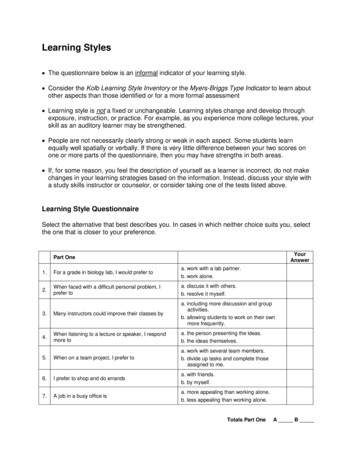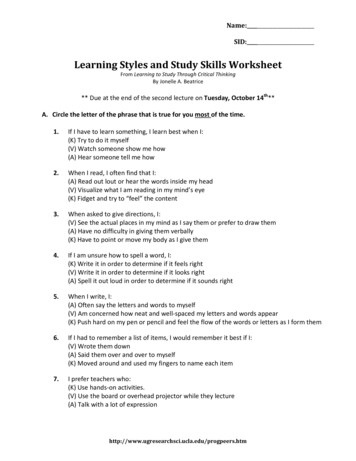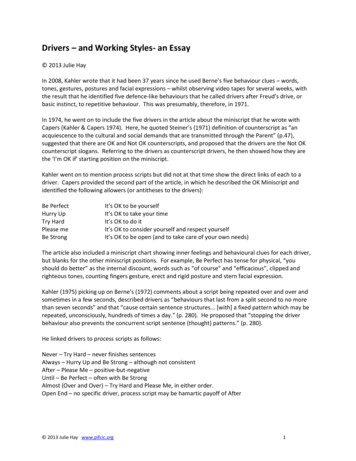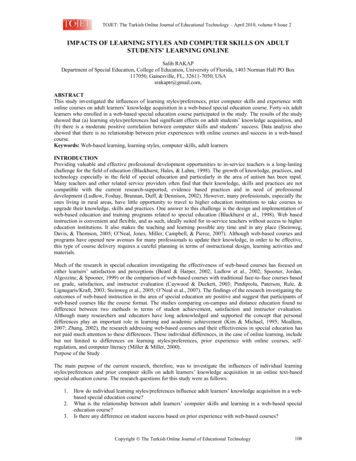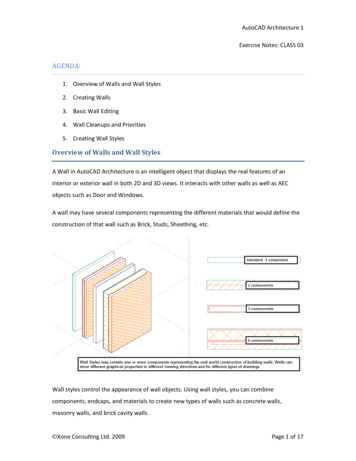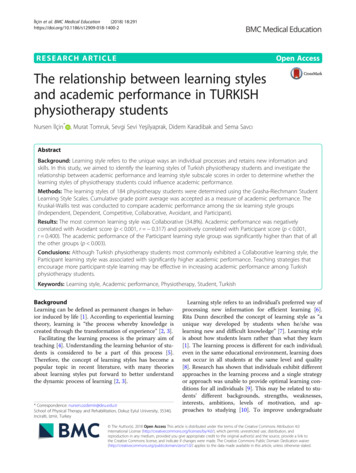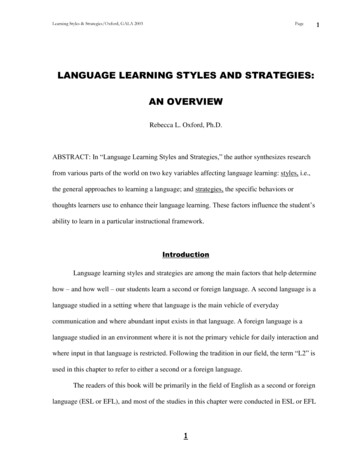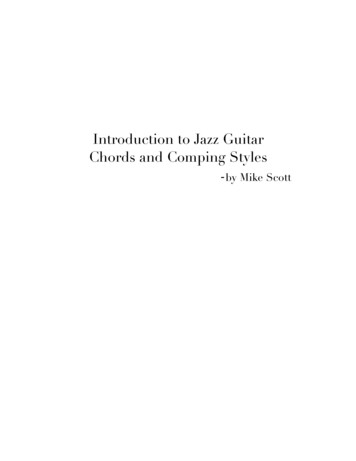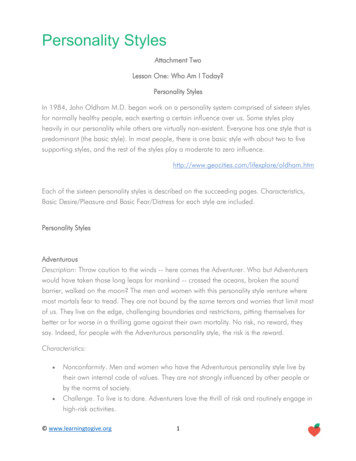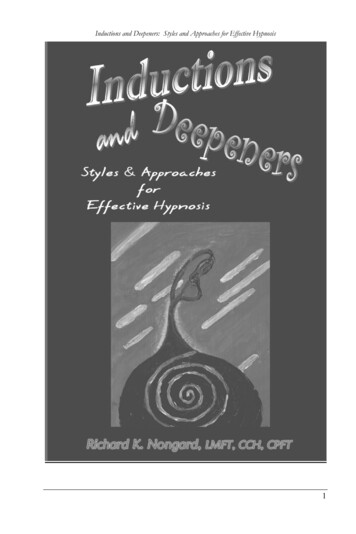
Transcription
Inductions and Deepeners: Styles and Approaches for Effective Hypnosis1
Richard K. NongardINDEXForeword .7by Michael JohnsIntroduction . 11Notes from Richard: Subjects, Scripts and The Point Why Use Hypnosis Understanding Induction Styles and Approaches Practice, Perfectionand ConfidenceThe Inductions . . .27Progressive Muscle Relaxation .29Eye Fixation .35Reverse Arm Levitation 41Ericksonian Style Confusion with Levitation 49Visual Imagery .57Fractionation with Discussion .65Fractionation with No Discussion .75Awareness . .81Classic Directive .89Rapid Induction .95Rapid Touch 99Child with Teddy Bear .109Child with Coin 123Zarren Marble Adaptation .133Dave Elman Style Count with Amnesia 141The Deepeners .149Classic Elman Count with Amnesia .153Simple Number Count .159Fractionation Number Countdown . 165Staircase .171Candelabrum .177Staircase with Fractionation . 185Bonus ScriptReverse Hypnosis Induction and Deepener .191Closing Thoughts .199Bibliography . . 201Recommended Reading .203Two Minute Commercial . 2052
Inductions and Deepeners: Styles and Approaches for Effective HypnosisFOREWORDBy Michael JohnsLas Vegas Stage Hypnotist and National Comedy Club PerformerIFYOU HAVE any experience with hypnosis at all, you know thatdoing hypnosis is quite easy, and yet it can be a bit complicated, all atthe same time.As Richard is fond of saying, all hypnosis is really self-hypnosis, so asthe hypnotist, you are the simply the tour guide for the subject’shypnotic trip. Your job is to discover where they want to go (assessthe goal), study the map and determine the best route to take(evaluate the hypnotic approach), and then lead them on their way(facilitate induction and suggestion).This simple three-step process applies whether you are a stagehypnosis entertainer like me, or a hypnotist who helps people quitsmoking, lose weight or get over their fear of public speaking.3
Richard K. NongardAnd either way, you won’t have to be in business very long to realizethat different groups and individuals sometimes require differentapproaches. Different entertainment venues may precipitate the needfor a more or less physically dramatic induction; different individualsmay respond better or worse to imagery, touch or sound.In an effort to be prepared for these situations, it’s best if you have awell-rounded resource to guide you through. As with anything, themore you know, the easier it will be to help your clients reach theirgoals, and that’s why I highly recommend Richard’s book, Inductionsand Deepeners, Styles and Approaches for Effective Hypnosis.I’ve had many conversations with Richard about hypnosis, and let metell you, the guy knows his stuff, inside out. Nevertheless, I must admitI was amazed by the quality of information in this text. It’s one thingto discuss an approach or style with someone face-to-face, but mosttextbooks fall short when it comes to conveying the finesse of this orthe subtleties of that. In Inductions and Deepeners, however, Richardcovers most every induction and deepening technique you could everneed to use, explains why and how it works, when to use it, and evenhow you can modify it for your own personal style. The language iseasy to read - no lofty diatribes or podium preaching - and thepractical concepts are right on and to the point.In real life, Richard is the kind of guy who’s there for you when youneed to sort out a problem or maybe get a little confidence boost, andI’m happy to see that these personality traits show through in thebook. I love the way he encourages you to just take the plunge anddo it; practice here and there and everywhere until you find yourselfconducting inductions in your sleep. It’s great advice. People areresistant to practicing hypnosis professionally because they lackconfidence, but they lack confidence because they don’t practicedoing hypnosis.I also like how he included transcripts from actual sessions rather thanjust typing out ready-made scripts. One benefit is that you can seehow easy it is for a confident hypnotist to instinctively respond to thesubject’s responses by improvising in the middle of a session. Effective4
Inductions and Deepeners: Styles and Approaches for Effective Hypnosishypnosis practice is about adaptation; you adapt approaches that areknown to work and tweak them to make them work for you, and youadapt your approach to the needs of your subject.Another benefit is that you get to see how spoken hypnotic languagepatterns really work. We are taught in school that when writing wemust dot this I and cross that T and put a comma here and so forth,but when we speak aloud to the subconscious, the rules ofgrammatical necessity change quite dramatically, and when you reada ready-made script, quite often vital language patterns and subtlehypnotic syntax are neglected in favor of English 101 sentencestructures.In my opinion, the selection of induction and deepener approachesRichard chose to include represent the perfect blend of classic andunique, and even demonstrate how a classic can be unique. Forexample, Eye Fixation is Eye Fixation, a common induction method.However, the subject’s eyes can be directed to fixate on a light, a stillobject, a swinging object, a color, a corner, a spot on a wall, or even aspot in the middle of the room, or the subject can be directed to selecttheir own point of fixation.Richard’s philosophy is this: Here’s the basic concept behind thisapproach, this is how and why it works, and here are some variations.Now, take it and make it work for you. He isn’t looking to create a cultfollowing of clones who use only his inductions word for word, butinstead encourages you to study and adapt these approaches into toyour own unique style.In summary, I am impressed with this book and I think you will be too.It’s full of easy to understand, motivating and practical informationthat you can actually use - and I hope you do! Michael JohnsMichael Johns, star of the hilarious Las Vegas comedy hypnosis show,“Hypnosis Gone Wild,” has entertained thousands across the country forover 15 years. You can find out more about Michael atwww.TwistedComedy.com or www.HypnosisGurus.com.5
Richard K. Nongard(Excerpted from the Introduction)THE SUBJECTS, THE SCRIPTSAND THE POINTThis text is filled with examples of hypnosis sessions. The first sectionfocuses on inductions and the second on deepeners. Each of thedemonstrations presented is a transcript of an actual session. With theconsent of the subjects, I filmed the sessions, and then had thecontent transcribed into printed form.I used four subjects. Three are adult females, from ages 25 to 37, andone male child, age 11. None of the subjects had ever beenhypnotized before, either for clinical or entertainment purposes.I chose these subjects because they were interested in learning abouthypnosis, they trusted me to be professional, they had no qualmsabout being videotaped, and they were available.All of the subject’s responses are real. The experiences that theydescribe and the transcribed phenomena that you may observe arereal; nothing was rehearsed or practiced. They represent typical clientswe might see on any given day.The sessions themselves are short or abbreviated - meaning they donot contain full suggestive therapy scripting - because they are fordemonstration purposes. I take the subject through the induction,give them a minute to enjoy the experience, and then wake them up.The deepening sessions are, of course, slightly longer.The exceptions are the two sessions with the child, Subject D. Thesesessions are more complete, as I thought it important for both thesubject’s comfort and the reader’s education to go through the entireprocess of facilitating hypnosis with a child.For the sake of simplicity, I use virtually the same three-count dehypnotizer or awakening method in each of these script examples, as6
Inductions and Deepeners: Styles and Approaches for Effective HypnosisI’m trying to demonstrate induction and deepening, rather than theskills of de-hypnotizing or awakening a client. However, since all ofthe participants in these sessions were actually put into trance, I didn’twant to just say to them, “Stop experiencing the trance, it’s time tomove on to the next demonstration,” so you will notice that each timeI hypnotize them and bring them into a state of decreased brainactivity, I also awaken them in a respectful manner.The point of this book is to provide you with scripts to learn from, sothat you can increase your repertoire of strategies, refine your skills,and develop and define your own style.Consider the language patterns I have used for the purposes ofbuilding trust, creating confusion, aiding relaxation, or suggestingnew behaviors. How can you incorporate or adapt them into yourown preferred style?Read the transcripts aloud and time the inductions. Some are quiteshort and others much longer. Which style is best for which of yourclients? And can you take a longer one and shorten it into an effectiveformat for the needs of your clients?Study my choice of metaphors vs. directive suggestions or thecombination of the two. Why might I have chosen one over the otherin each circumstance, and would you have made the same choice?See how easy it can be to adapt or modify a standard approach intoyour own style, simply by changing the object of focus from astaircase to an elevator. Perhaps you have a great idea to substitutebig, puffy Sesame Street type letters for the numbers I used, that Iadapted from Dave Elman.My thought is that if I can demonstrate the process of hypnosis in avariety of different ways, and provide you with a written text to studyconveniently any time you wish, you too will be able to learn manynew tactical strategies that can be useful to the clients on yourcaseload and the work that you do.7
Richard K. NongardAlso AvailablefromLearnClinicalHypnosis.comOn DVD: Learn Hypnosis: How to Hypnotize Anyone Hypnotic Inductions: Methods that Work Richard Nongard’s Inductions and Deepeners Improve Recall and Test-Taking Skills with HypnosisOn CD: Quit Smoking with HypnosisLose 20-100 Pounds with HypnosisFly Fear FreeImprove Your Golf Game with HypnosisIncrease Sexual Performance with HypnosisPMR Therapeutic RelaxationRelaxation and Empowerment with HypnosisAlso AvailablefromHypnosisGurus.comSecrets from Las Vegas Insiders DVD Series: Michael Johns’ Stage Induction Michael Johns and Richard Nongard present Stage HypnosisExposed Terry Stokes presents The Stage Show Induction:: How toHypnotize Anyone8
Las Vegas Stage Hypnotist and National Comedy Club Performer IF YOU HAVE any experience with hypnosis at all, you know that doing hypnosis is quite easy, and yet it can be a bit complicated, all at the same time. As Richard is fond of saying, all hypnosis is really self-hypnosis, so as the hypnotist, you are the simply the tour guide for the subject’s hypnotic trip. Your job is to discover .
